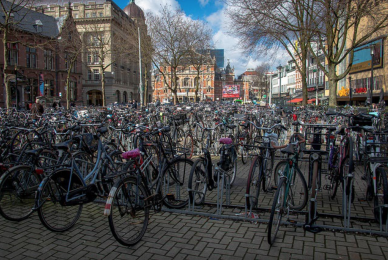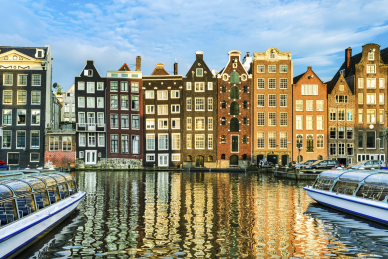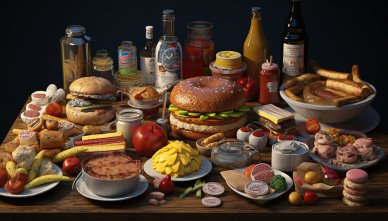The Netherlands
The Netherlands is the biggest Benelux country and one of the richest in Europe.
People pay tribute to their own history and culture and show much respect to other ethnicities.
Everyone who has had the luck to come here calls this place a heaven on earth.

General Information
This most densely populated European country is conveniently located on the coast of the North Sea. It also has land boundaries with Belgium to the south and Germany to the east. The western border is maritime - it takes a couple of hours to get to the United Kingdom by ferry.
‘Netherlands’ means low-lying countries. It seems as though the high seas try to conquer each meter of the Dutch land. Indeed, one-third of the Netherlands’ territory is located 5-7 metres below sea level, and over half the population lives in the lowlands.
There are many villages and towns without tar roads, so buying groceries for local people turns out to be a boat trip.
An immense effort of residents lies behind the magnificent Dutch sceneries. Those people have erected loads of dams and dunes to protect lands from flooding. Even the capital’s name, Amsterdam, translated from the Dutch, has a practical meaning - “Amstel dam”. Amstel is one of the city’s two rivers.
The Netherlands is a kingdom that consists of 12 provinces:
- North Holland (capital city – Haarlem)
- South Holland (The Hague)
- Friesland (Leeuwarden)
- Flevoland (Lelystad)
- Limburg (Maastricht)
- Utrecht (Utrecht)
- North Brabant (Hertogenbosch)
- Zeeland (Middelburg)
- Drenthe (Assen)
- Gelderland (Arnhem)
- Groningen (Groningen)
- Overijssel (Zwolle)
Interestingly, Flevoland is the last province founded in 1986. It emerged as a result of enormous land improvement in the central part of the Kingdom.
So there is a logical reason why they say that God created the earth, but the Dutch created the Netherlands.
The climate here is mild: no hot summers and no cold winters. The average temperature in summer is 17°C - 19°C, and 0°C - +2°C in winter. That is why the Netherlands is a perfect place for those who cannot stand extreme temperatures.
The Netherlands has a population of 17 million people whose standard of living is among the highest in the world - the Kingdom ranks fourth in the European Union and thirteenth in the world. Though Dutch is an official language in the country, citizens are hyperglots.
Almost all adults and even children speak English fluently, and the majority speak German as well.
The currency is the euro, which replaced the guilder in 2002.
Directions
The Netherlands is a favoured travelling destination for tourists from all over the world. Around ten million people come here every year. According to statistics, the most frequent visitors to this country are the Americans, the British, and its closest neighbours - the Germans and Belgians.
Everyone willing to have a trip to this country should know that they might need a visa, the type of which depends on a traveller’s nationality, destination, and length of stay. The Netherlands is accessible by land, air, and sea.
Travelling by Land
Land routes lie across Germany and Belgium with the perfect lines for high-speed trains and buses. For example, it will take around six and a half hours and cost on average €100 to get to Amsterdam from Berlin by train.
The same route by bus will take ten hours but the price will be half cheaper - €30-€50.
It takes two hours by train and costs €60 to get to the Netherlands’ capital from Brussels. If a tourist decides to pay the full price, a bus trip will cost €24. Special offers or booking the tickets three months in advance will reduce the trip cost to €11 or even €9.
Those who feel much better in the driver’s seat should hire a car. In Europe, this service may cost around $70 a day. There is one more option available - a private transfer offered by special service agencies. Travel time between Brussels and Amsterdam is about three hours.

Amsterdam bikes
Flights
There are airports in every province, so if you need to get there as quickly as possible, you should opt for booking a plane ticket. The flights are provided by KLM Royal Dutch Airlines, the oldest airline company in the Kingdom.
Schiphol, constructed more than a hundred years ago on the site of a dredged lake, is Amsterdam's international airport. It has six runways now, which makes it the fourth largest in Europe.
Travelling by Sea
Two ports, Kale and Dunkirk, offer their ferry services to help tourists get to Amsterdam, and the port of Hull - to Rotterdam. Ferries are available every two hours, and the trip itself will take 1h 45m.

Accommodation
Amsterdam is an expensive city, but this does not necessarily mean spending a fortune on a hotel room. There are budget hotels at affordable prices, good enough to accommodate tourists.
The pricing policy of the Dutch hospitality business has been affected by the coronavirus pandemic - the prices have dropped by a third.
Choosing a hotel in the city centre demands taking into account certain things. For instance, all these hotels are housed in ancient buildings aged 300 - 400 years. There are no lifts, and the architecture is about small and low rooms, circular, narrow, and steep staircases. So it will be troubling enough to carry heavy suitcases up those stairs.
Serving breakfasts is not a common thing in all hotels, and most often they are very simple. Tourists run the risk of getting an empty stomach after a small cup of tea or coffee, a couple of sandwiches with butter, several slices of cheese and sausage. However, almost everywhere on the ground floors, there are round-the-clock vending machines that offer snacks and drinks.
An obvious advantage of hotels in Amsterdam is their close proximity to the majority of places of interest. They are located around a half-an-hour drive from the airport. And it takes from 7 to 15 minutes by public transport to get to the Amsterdam Centraal Station.

Amsterdam architecture
The top five budget Amsterdam hotels and hostels are as follows:
- Hotel V Frederiksplein is a hotel located in the city centre near Dam Square, with a lot of shops, and restaurants. The rooms have central heating, bathrooms, and big beds - full and king. Non-smoking rooms are available as well.
- Flipper Hotel is located not far from the centre. The rooms are small and clean with all facilities needed for having a snack - a kettle, tea and coffee, sugar, and cream. There are shared bathrooms with available shampoo and soap. Breakfasts can be served for an additional charge.
- La Belle Vue is the hotel housed in the monumental shopping gallery. The building is very beautiful with small but cosy rooms and friendly staff.
- DiAnn is a small hotel with heated, clean, and cosy rooms. The staff are very friendly. Rooms include bathrooms, fridges, and safes.
- Anna-Maria is a cheap youth hostel with the minimum facilities. The best prices range from Sunday to Thursday, and weekends are usually much more expensive. The rooms are not big but can accommodate up to ten beds. There is free Wi-Fi, a kettle, and a microwave to cook some breakfast or snacks. The bathrooms are clean.
Places to See in the Netherlands
The history of all major cities of this Western European country dates back to the 13th - 15th centuries, so there is always much to see.
Besides, the Netherlands has been the centre of the development of European culture and architecture for hundreds of years.
Paintings, houses, and bridges, well-preserved due to the efforts of restoration artists, attract art admirers from all over the world.
Architecture
The historical architecture of the Dutch cities has its distinctive and recognisable appearance. Three- and four-storey houses with sloping gabled roofs are built abutting each other. They crowd narrow streets and embankments of innumerable canals.
The explanation of this fact is very simple. At all times, each metre of land in the Netherlands has been as valuable as gold. That is why in the Middle Ages, builders often could not afford to construct houses even one metre apart from each other.
Central streets in the cities are so narrow that they can be appropriately called the back streets. Houses there face each other through their windows at a distance of two slender people hardly passing each other.
Central parts in the cities were constructed 500-800 years ago on the banks of water-abundant rivers, so many of them stand on stilts. There is a saying in Amsterdam that one cannot jump and walk loudly in the house because it may sink under the water.
Stilts have started biting the dust in some parts after so many centuries. If those ancient houses had not been abutting each other from both sides, they would start ruining now despite all attempts of modern architects.
Canals
A major part of the Netherlands is located below sea level, so many cities here bear much resemblance to Venice with canals and their embankments.
It is a must to go on a motorboat tour through Amsterdam canals. You will be overwhelmed with emotions and impressions after this spectacular walk and gripping stories of a tour guide.
Cheese Market Festivals
Any visit to the Netherlands is impossible without enjoying the delicious Dutch cheese. Every year, this ‘cheese heart’ of Europe holds festivals, the colourful cheesemakers’ celebrations that are more shows than ordinary marketplaces.
There are only five cities that organise the festivals. Their names are famous for corresponding to the varieties of cheeses: Gouda, Edam, Alkmaar, Hoorn, and Woerden. The fests usually take place in summer, but only the Alkmaar cheese market operates from the end of March to September.
A Bit of Spice
There are few places in the world where human frailties are given such a positive attitude as in the Netherlands. Amsterdam has excelled in this field with its famous De Wallen, the Red-Light District. Here, many forms of erotic entertainment are available. There are window brothels, erotic movie theatres, nude magazines, and coffeeshops offering cannabis.
A coffeeshop is a place where cannabis can be smoked or sold on a legal basis. However, there are still some restrictions: coffeeshops are not allowed to sell cannabis to minors, and what is more, they cannot sell more than five grams per customer.
Top 10 Netherlands Destinations
Tourists coming here usually are short of time, and this becomes a problem as there are so many attractions, real eye-openers.
Below is the top ten of must-see places in the Netherlands:
- Rijksmuseum is the biggest museum in the capital located within several quarters. A famous collection of Flemish paintings is gathered here and includes the masterpieces of the Brueghel brothers, Paul Bril, Jan van der Straet, and others.
- Keukenhof is a paradise not far from Amsterdam. The National Flower Garden features very rare species of plants. This lush spectacle can be enjoyed during several months when the park in its full bloom is open for visitors.
- Anne Frank House is a tinge of sadness in the trip. It is the biographical museum of a small Jewish girl, the author of the harrowing wartime diary. The book has been translated into all languages. A house is a place of sorrow and an eternal fascist reminder for humanity.
- Maritime Museum Rotterdam features real ships, panoramic sights of battlefields, sailors’ armours, and other interesting exhibits.
- Cube Houses (Rotterdam) are innovative constructions tilted 45 degrees according to the idea of the Dutch architect Piet Blom. The Houses are considered one of the most prestigious districts of the city.
- Dom Church (Utrecht), also called St. Martin’s Cathedral is 112 metres high. It was built in the 16th century in Gothic style.
- Sonnenborgh Observatory is an astronomical museum in Utrecht founded as a part of a local university. It housed the Royal Dutch Meteorological Institute for many years.
- Binnenhof in The Hague is a former royal residence currently housing the office of the Prime Minister of the Netherlands.
- Ridderzaal is a castle with a royal dynasty throne room in Binnenhof. The Dutch King delivers the speech from the throne here every year.
- Dam Square and Royal Palace of Amsterdam is one of the three palaces possessed by the monarch family. It is open for tourists on days free from formal receptions.
These are not all places of interest in one of the most beautiful corners of Europe. Perhaps, a couple of years are necessary to explore the entire Kingdom and go on insightful tours on a daily basis.
The Dutch Cuisine
Herring and cheese are two obvious dishes that may spring to mind when it comes down to the national cuisine of the Netherlands. Indeed, these two products made the country famous many centuries ago.
If you want to feel like a real Dutch, take a trip to the cheese festivals or try to eat pickled oily herring in the manner people do here: hold it by the tail above your head, and bite the fish piece by piece.

The Dutch Cuisine
Local residents highly esteem the fish. There are hundreds of recipes in Dutch cuisine that include baked, pickled, and fried variations.
The Dutch people cannot spend a day without meat either. Hotpot is mashed vegetables and beef; hutspot is a meat stew combined with carrots, potatoes, and onions. These dishes are included in the menu of each cafe and restaurant.
The other local dish is stamppot made of stewed or boiled mashed vegetables like potatoes, onions, and carrots too. It may be served either separately or as a garnish with sausage or small meatballs. The Dutch also like eating potatoes cooked in different ways. Particularly, they fancy French fries with mayonnaise, which is the most popular local fast food.
What about sweet courses, the Netherlands’ residents are fond of stroopwafels (a peculiar type of wafers with a caramel filling), liquorice sweets, and any other desserts made of liquorice. Pudding similar to custard in molds is very popular. It has very different tastes: vanilla, chocolate, fruit, etc. Sponge pudding with apples and whipped cream is also among the favourites.
Restaurants and cafes are very multinational as well as the country itself. A visit to Amsterdam or any other city will be more pleasant due to the opportunity to taste Italian pizza, Arabic kibbeh, Turkish sweets, or Russian caviar blinis.
Top 5 Interesting Facts about the Netherlands
Apart from the fascinating architecture and places to see, the country has a lot of unusual things in its history and reality. Below are five facts that will complete the image of the Kingdom of the Netherlands:
- Starting from January 1, 2020, the country cannot be referred to as Holland anymore. This government decision means that only the name ‘the Netherlands’ can be used. The name ‘Holland’ can be applied only to two provinces - South Holland and North Holland.
- One country, two capitals: though the official capital is Amsterdam, the Hague is the city of the Dutch government.
- This country is a paradise for cyclists. The number of bicycles exceeds the number of local residents by several times, and the cycling injury rate is the lowest in the world.
- The three Caribbean islands - Bonaire, Sint Eustatius, and Saba - also belong to the Kingdom of Netherlands as its colonies. Their citizens even have the right to take part in the Dutch elections.
- Tolerance towards human frailties is a distinct feature of the Dutch mentality. That is why in 2001, the Kingdom was the first one to legalise same-sex marriages.
That is the way the country of tulips, mills, and cheese is. If you ever visit the Netherlands, you will definitely see a true Europe.
